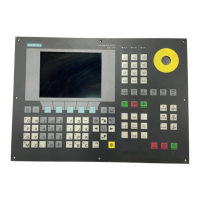Detailed Description
2.11 Tool lengths L1, L2, L3 assignment: LENTOAX
Tool Compensation (W1)
Function Manual, 08/2005 Edition, 6FC5397-0BP10-0BA0
2-151
Further explanations
If the tool length components are parallel to the geometry axes, the axis indices assigned to
length components L1 to L3 are returned in the _AXIND array.
If a tool length component points in the negative axis direction, the associated axis index
contains a minus sign. In this case, the return value (status) is 0. If an axis does not exist,
the associated return value is 0. The assignment can also be read from the _MATRIX
parameter. Six of the nine matrix elements are then zero, and three elements contain the
value +1 or -1.
Note
In the TCS, all tool length components are always parallel or antiparallel to the axes.
The components can only be antiparallel if setting data:
SD42900 $SC_MIRROR_TOOL_LENGTH
is enabled and mirroring is active.
If not all length components are parallel or antiparallel to the geometry axes, the index of the
axis, which contains the largest part of a tool length component, is returned in _AXIND. In
this case (if the function does not return an error for a different reason), the return value is 1.
The mapping of tool length components L1 to L3 onto geometry axes 1 to 3 is then
described completely by the contents of the 3rd parameter _MATRIX.
The _COORD parameter can be used to specify, which coordinate system is to be used for
the geometry axes. If the _COORD parameter is not specified
(notation LENTOAX(_AXIND, _MATRIX)), the WCS is used (default).
Example:
Standard situation: milling tool with G17
L1 applies in Z (applicate), L2 applies in Y (ordinate), L3 applies in X (abscissa).
Function call in the format
status = LENTOAX(_AXIND, _MATRIX, "WCS")
The result parameter _AXIND contains the values:
_AXIND[0] = 3
_AXIND[1] = 2
_AXIND[2] = 1
Or, in short: ( 3, 2, 1)
In this case, the associated matrix _MATRIX is:

